Injection molding is a method of manufacturing parts in which material is injected into a mold at high pressure to form the desired shape in the mold. Traditionally, the materials commonly used for injection molding are plastics, but now injection molding can also be used for the manufacture of metals, such as aluminum materials.
Advantages of injection molded aluminum materials
The advantages of injection molded aluminum are its lightness and strength, as well as its good electrical and thermal conductivity. These characteristics make injection molded aluminum materials widely used in automotive, aerospace, medical equipment, electronic equipment and other fields.

The manufacturing process of injection molded aluminum materials
The manufacturing process of injection molded aluminum materials can be divided into the following steps:
1. Designing a mold: Based on the shape and size of the desired part, the applicable mold is designed and manufactured. The molds are usually made of steel or aluminum with high strength and high wear resistance to withstand the force of high pressure injection.
2. Preparing the material: Aluminum material needs to undergo a series of processing, including melting, casting, and extrusion, to obtain the desired shape and properties. Usually, aluminum materials need to add a certain amount of alloying elements to improve their strength, hardness, corrosion resistance and other properties.
3. Heating the aluminum material: Heating the aluminum material to a liquid state usually requires the use of a high-temperature furnace or induction heater. The melted aluminum material needs to be kept within a certain temperature range to ensure material flow and uniformity during the injection molding process.
4. Injection molding process: The molten aluminum material is injected into the mold through a high-pressure jet and allowed to cool and solidify to form the desired part. The injection process requires precise control of temperature, pressure, injection speed and other parameters to ensure that the parts produced meet the required specifications and performance.
5. Removal of the part: After the part has cooled completely, the mold is opened and the part is removed. The part usually requires subsequent machining and processing, such as cutting, drilling, grinding, etc., to obtain the required dimensions and surface quality.
Overall, the manufacturing process of injection molded aluminum materials requires a high degree of technical and equipment support, but its efficient and precise manufacturing methods make it promising for a wide range of applications in many fields.

Application limitations of injection molded aluminum materials
The main limitations of aluminum injection molding are as follows:
Higher manufacturing costs: Compared to traditional casting methods, injection molding requires the fabrication of high-quality molds and high-temperature and high-pressure machining processes. These costs are usually higher, and therefore the manufacturing cost of injection molded aluminum materials is also higher.
Suitable for low volume production: Injection molding technology is usually suitable for low volume production because the time and cost to manufacture the molds are higher, and it can be very difficult to change the size or shape of the parts once the molds are made. Therefore, injection molded aluminum materials are usually used to produce parts in small quantities or for individual needs.
Not suitable for large parts: Injection molding technology is usually suitable for small or medium-sized parts, because large parts require larger molds and larger injection molding machines, and their manufacturing costs and technical requirements are also higher.
Limited surface quality: The surface quality of injection molded aluminum materials is affected by the mold, so subsequent surface treatments, such as grinding and polishing, are required. Compared with the casting method, injection molding has higher surface quality requirements and requires more surface treatment processes.
High requirements for material properties: The manufacturing process of injection molded aluminum materials requires the use of high temperature and pressure, which may have an impact on the structure and properties of the material. Therefore, injection-molded aluminum materials usually require the use of high-quality aluminum materials to ensure that their strength, hardness, corrosion resistance and other properties meet the requirements.
In general, although injection molded aluminum materials have many advantages, their application limitations need to be carefully considered. When selecting manufacturing materials and methods, reasonable choices need to be made based on specific needs and budgets.
XY-GLOBAL has a rigorous process for every step of the way from production to mass production. If you need custom parts related to aluminum injection molding, contact xy-global to have your problem solved by a professional engineering team and get high quality on-demand parts with professional prototyping and production capabilities. Our quotes and DFM analysis can be completed online in minutes, and quality parts can be delivered in days.













Share:
Surgical Blade Manufacturing, from Materials to Process, Is the MIM Process Viable
Four Processes for Making Metal Powder